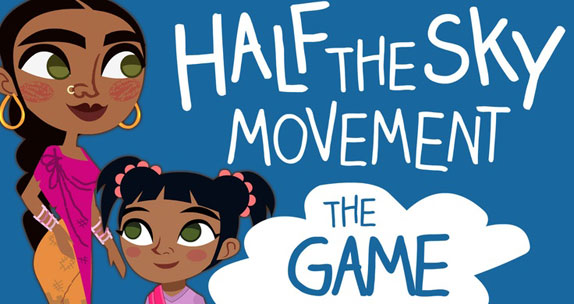Half the Sky: Turning Oppression into Opportunity for Women Worldwide was always designed to be more than a book or a documentary series—that’s why it’s called the Half the Sky Movement. To add momentum to the cause, Half the Sky collaborated with Games for Change to create a buzzworthy Facebook game launched earlier this week. It’s already been talked about in The New York Times, Fast Company, and VentureBeat.
In the game, Facebook users battle against issues as heavy as child prostitution, according to The New York Times. They progress through a virtual story about an Indian woman raising money for her sick daughter, and unlocking money from actual donors ($500,000 pledged by The Pearson Foundation and Johnson & Johnson) along the way. The money funds select Half the Sky NGO partners: the Fistula Foundation, GEMS, Heifer International, ONE, Room to Read, the United Nations Foundation, and World Vision.
Asi Burak, Co-President of Games for Change, shared how a game could possibly raise awareness about complex social issues.
How is it possible for something as lighthearted as a game to convey such serious subjects as genital mutilation and child prostitution?
At Games for Change, our mission is to promote the creation and distribution of games for social causes. The idea that a game can deal with serious issues is nothing but new. We had developers in our community tackle conflict resolution, HIV/Aids, or the Darfur genocide.
We believe it is mainly a matter of perception and that with time we will start seeing interactive experiences that are as successful as documentaries or non-fiction books or graphic novels. If you look at each one of the media I listed, it took decades for them to evolve and diversify until they were able to address such a range of topics, tastes, and ages. This will happen with games, too.
In the meantime, and to address the issue of perception, we made some deliberate design choices. For example, focusing on the solutions and progress more than the oppression and challenges. You will not find in the game, in most of its parts, scenes that are as graphic or as tough to engage with as what you’ll find in the documentary or the book. The game begins with a woman who decides to take a stand and improve her situation. Mainly economically and socially. That experience “opens her eyes,” and she is then able to help other women and girls around her, and travel to other countries. The issues become more difficult once we feel the player has more capacity to handle them in that context.
Who is your target audience?
Facebook players. It’s a very unique demographic, much wider than other game platforms: 15-45 in age, with 55 percent women versus 45 percent men in the U.S. It’s an audience that seeks casual experiences, usually divided to short sessions of 15 minutes a day.
What will happen after players unlock all $500,000 already pledged by The Pearson Foundation and Johnson & Johnson?
We created a platform that is suited to add other sponsors. But the core is going to be there no matter what, where players can engage with the issues, make their own donations, or decide to share facts and stories on their Facebook wall.
Why did you wait to release the game now, a few months after the Independent Lens premiere of Half the Sky: Turning Oppression into Opportunity for Women Worldwide?
We originally planned to launch the game with the TV series (Fall 2012). However, the funding and production time-lines of both projects did not merge. We therefore chose an alternative strategy of rolling launches, so each time, the Half the Sky Movement has a new and exciting story to tell. The Facebook game was selected to be the leading story for International Women’s Day of 2013, and it was launched on March 4th the same exact day of the re-broadcast of night two. It was the first occasion that both book, TV series, and game were available to consumers on the same day. And each component expands the range of audiences we can reach.
How did you choose the non-profits included in the game?
There is already an established coalition of 30+ non-profits that are part of the Half the Sky Movement. Many of those are some of the world’s leading organizations in women and girls’ issues and solutions. Out of this list we chose a selection that covers all the topics featured in the game: women’s health, gender-based violence, sex trafficking, economic empowerment and education.
The other dimension was the organizations’ capacity and enthusiasm around new media and exploration. They are beneficiaries, but it also demanded their time and effort as content experts and partners. Working with them was an incredible learning experience, and their feedback was crucial to get this to the finish line.
What do you hope Facebook users will take away from the experience?
Most players are so unaware that they come back and report that it opened their eyes to those issues. They get a better understanding of the topic, but also the solution and the non-profit organization that is connected. Others tell us incredible stories of parents and kids playing together and how the parents use the game to instill values of social responsibility and giving. It is all very new and fresh so the feedback is limited, but so far we’re overwhelmed with positive feedback and impact in ways we didn’t necessarily expect.
